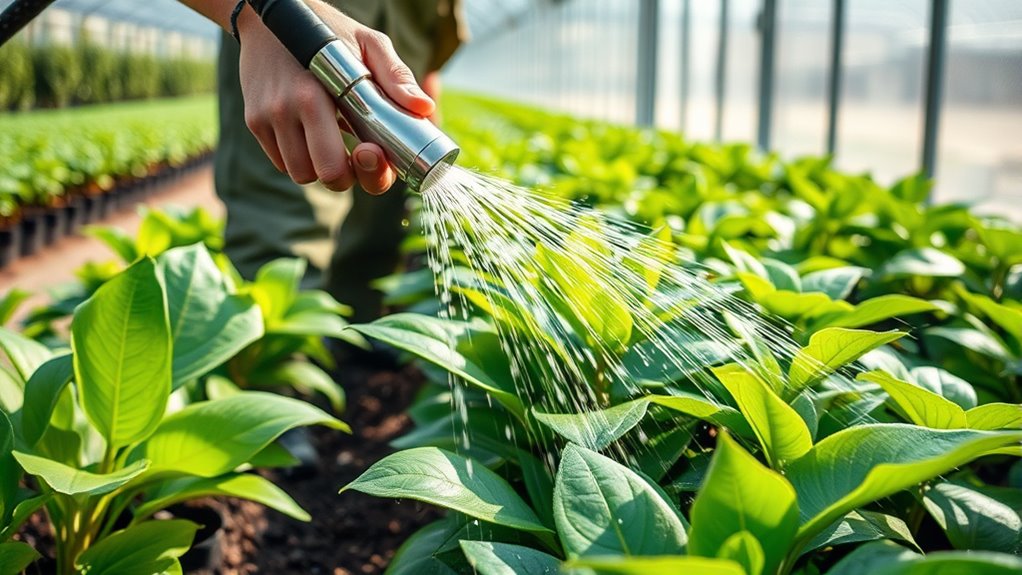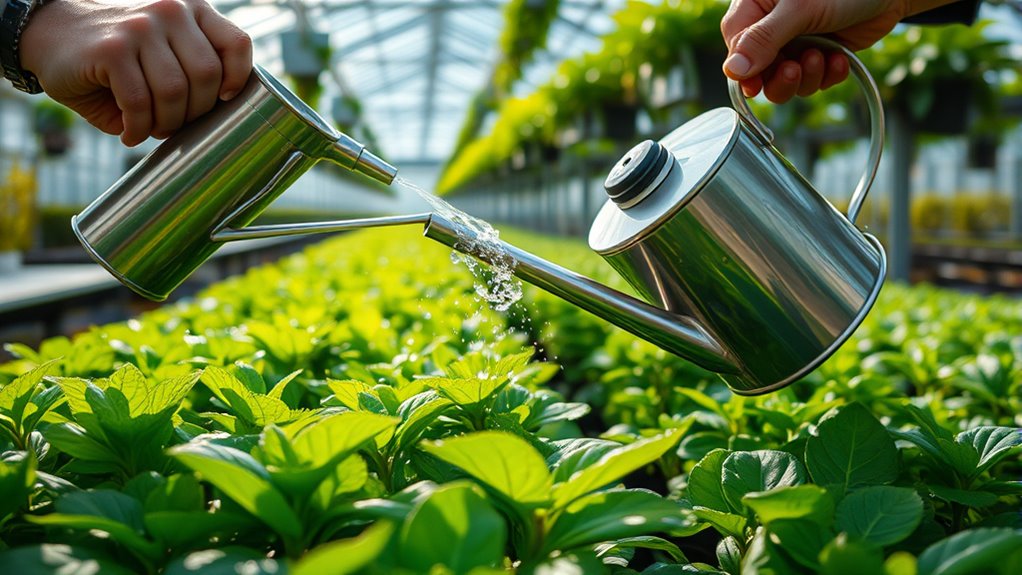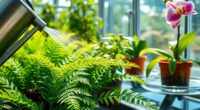To water greenhouse plants properly, make certain you deliver the right amount of moisture without overwatering. Use drip irrigation systems to direct water to each plant’s base, minimizing waste and maintaining consistent moisture levels. Incorporate moisture meters to monitor soil or medium moisture content, allowing you to adjust watering times and frequency. Regular checks will help prevent root rot or drought stress. Keep these tips in mind, and you’ll discover more ways to optimize your watering routine effectively.
Key Takeaways
- Use drip irrigation to deliver water directly at the plant base, reducing waste and ensuring consistent moisture.
- Regularly check soil moisture with a meter to determine if plants need watering.
- Adjust watering frequency based on soil moisture readings and plant needs to prevent over- or underwatering.
- Install adjustable emitters to control water flow and match each plant’s specific requirements.
- Maintain a consistent watering schedule to promote healthy growth and prevent root diseases.

Watering greenhouse plants properly is essential for their healthy growth and development. When you provide the right amount of water, you help your plants absorb nutrients effectively and prevent issues like root rot or dehydration. One of the most efficient ways to water your greenhouse plants is by using drip irrigation systems. These systems deliver water directly to the base of each plant, reducing waste and ensuring consistent moisture levels. With drip irrigation, you can set timers to automate watering schedules, giving your plants exactly what they need, when they need it. This method minimizes overwatering and underwatering, which are common problems in greenhouse management.
To further refine your watering routine, moisture meters become invaluable tools. These devices help you accurately measure the moisture content in your soil or growing medium. Instead of guessing whether your plants need water, you can insert a moisture meter into the soil and get an immediate reading. This allows you to make informed decisions about when to water, ensuring your plants aren’t sitting in soggy or overly dry conditions. Using moisture meters is especially helpful in larger greenhouses, where it can be challenging to assess soil moisture visually or by feel alone. With consistent monitoring, you avoid the common mistake of watering based on time or intuition, which often results in inconsistent plant health.
Implementing drip irrigation combined with moisture meters streamlines your watering process and enhances your plants’ wellbeing. Start by installing a drip system tailored to your plant types and greenhouse layout. Adjust the emitters to deliver the right amount of water to each plant, considering their individual needs. Regularly check soil moisture levels with a moisture meter to fine-tune your watering schedule. If the meter shows moisture levels are high, hold off on watering until they drop to the ideal range. Conversely, if the soil is dry, increase watering frequency or duration. Over time, you’ll develop a precise routine that promotes vigorous growth and healthy roots.
Frequently Asked Questions
How Often Should I Water Different Types of Greenhouse Plants?
You wonder how often to water different greenhouse plants. Your watering schedule depends on each plant’s hydration levels, which vary by species, size, and environment. Check the soil regularly; if it feels dry an inch below the surface, it’s time to water. Avoid overwatering by ensuring proper drainage. Adjust your watering frequency based on the plant’s needs, seasonal changes, and humidity to keep your plants healthy and thriving.
What Signs Indicate My Plants Need More or Less Water?
You’ll notice your plants need more water if their leaves start wilting or become limp, indicating dehydration. Conversely, if you see discoloration spots or mold, it suggests overwatering. Keep an eye on the soil; it should feel moist but not soggy. Adjust your watering schedule accordingly, ensuring you provide just enough water to keep your plants healthy without risking root rot or drought stress.
Is It Better to Water Early Morning or Evening?
Ironically, choosing between morning or evening watering isn’t as simple as it sounds. Your watering schedule should prioritize water temperature and plant needs over convenience. Morning watering is ideal because it allows plants to absorb moisture before the heat, reducing disease risk. Evening watering might seem easier, but it can lead to damp conditions overnight. Ultimately, watering early helps maintain ideal health by promoting proper water temperature and absorption.
How Can I Prevent Overwatering in My Greenhouse?
To prevent overwatering, you should monitor soil moisture regularly and avoid watering on a fixed schedule. Using drip irrigation helps deliver precise amounts of water directly to the roots, reducing excess. Check soil moisture with a meter or finger test before watering, ensuring the soil isn’t overly wet. This way, you maintain healthy roots and prevent issues caused by overwatering, keeping your greenhouse plants thriving.
What Tools Are Best for Watering Greenhouse Plants Effectively?
To water greenhouse plants effectively, you need the right tools. Watering cans are great for precise watering, especially for individual plants or delicate seedlings. Drip irrigation systems provide consistent moisture to multiple plants, reducing overwatering risks. Both tools help you control water application, ensuring your plants receive just the right amount. Choose watering cans for small-scale or detailed watering, and install drip irrigation for larger setups to save time and maintain ideal moisture levels.
Conclusion
Remember, proper watering is essential for your greenhouse plants’ health. Consistent, appropriate watering can boost growth by up to 30%, ensuring your plants thrive. Avoid overwatering to prevent root rot and underwatering to cause stress. By monitoring soil moisture and adjusting your watering schedule, you’ll create the perfect environment for your plants to flourish. Stay attentive and proactive—your plants will reward you with vibrant, healthy growth every time.









